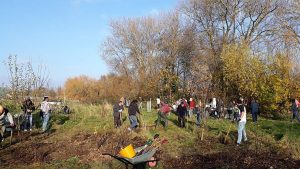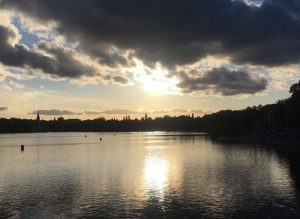If you have a constantly damp patch, don’t ignore it, turn it into a feature. There are plenty of plants that thrive in boggy conditions, adding to the range you can grow. If you’d like to create a bog garden it is easily done.
A bog garden can be any size but the soil does need to be about 30 cm (12”) deep to allow the plant root systems to develop. Some low spots can be used to form natural bog gardens but on a free draining site, a butyl rubber, plastic or similar waterproof liner will be needed to keep the area moist. Line parts of the bottom, leaving areas clear so the excess water can escape.
Unless your soil is particularly poor, it should be kept for filling the liner because it will closely resemble the surrounding soil and be more compatible with it than any imported compost. Weeds however may be a problem in the early stages. For the best effect, a bog garden linked to an adjoining pond is perfect, with the overflowing water from the pond seeping into the bog garden. On the other hand, bog gardens work very well as stand alone features.
The best position
This is invariably in dappled shade. Many of the plants grown here are herbaceous perennials which grow rapidly in the spring producing large soft tender leaves because of the damp conditions. This makes them susceptible to spring frosts and leaf scorch in hot bright sun.
The best plants
The following list shows native plants suitable for a bog garden:
- Fleabane (pulicaria dysentarica)
- Sneezewort (achillea ptarmica)
- Ragged robin (lychnis flos-cuculi)
- Marsh cinquefoil (potentilla palustris)
- Purple loosestrife (lythrum salicaria)
- Marsh bedstraw (galium palustre)
- Hemp agrimony (eupatorium cannabinnum)
- Cotton grass (eriophurum augustifolium)
- Greater birdsfoot trefoil (lotus uliginosus)
- Skullcap (scutellaria galericulara)
- Lady’s smock (cardamine pratensis)
- Bur reed (sparganium erectum)
- Bog asphodel (narthecium ossifragrum)
- Cypress sedge (carex pseudocyperus)
- Devils bit scabious (succusa pratensis)
- Glaucous sedge (carex flacca)
- Lesser reedmace (typha augustifolia)
- Lesser spearwort (ranunculus flammula)
- Marsh marigold (caltha palustris)
- Marsh woundwort (stachys palustre)
- Water forget-me-not (myosotis scorpiodes)
- Yellow flag iris (iris pseudacorus)
When you first plant up your marshy zone you should water it really well but thereafter you shouldn’t worry too much about it drying out. Natural marshes dry out from time to time and the plants will be well able to cope. A few days living in dry soil will do them no harm.

Reproduced with permission of North West Parks Friends Forum







